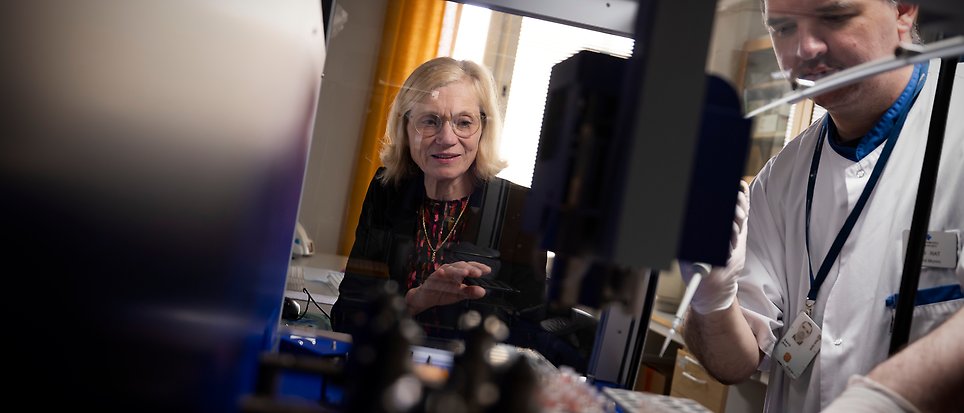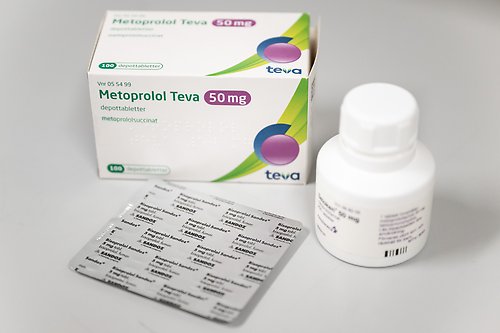Clinical Pharmacogenetics and Osteoporosis

Genetic and environmental factors play important roles for the development of osteoporosis and other diseases, but also for how individuals respond to drug treatment. Starting with the question why the incidence of osteoporosis is so very high in Sweden, we are investigating genetic - and environmental risk factors for this disease. In our pharmacogentic research programs, we look for genetic differences between individual that can explain variable responses to pharmaceutical drug treatments, with the goal to enable personalized drug dosage.
Description of our research
Our research group has two separate research focuses – one group focuses on osteoporosis and another focuses on clinical pharmacogenetics.
Each year some 14 000 Swedes suffer from hip fracture, the most serious consequence of osteoporosis. Through epidemiological studies we have shown that a high intake of Vitamin A correlates with an increased risk of osteoporosis. We are now trying to identify additional risk factors, and are studying the molecular mechanisms responsible for the bone toxicity of Vitamin A.
Finding the right medication and optimal dose involves a balance to maximise the positive effects and minimise the negative consequences of treatment – the adverse effects. Sometimes genetic factors play a crucial role in why some people experience severe adverse effects. The goal of our research is to tailor treatment to the patient through precision medicine.
Publications
Identification of risk factors for adverse drug reactions in a pharmacovigilance database
Part of Pharmacoepidemiology and Drug Safety, 2024
No link between type I interferon autoantibody positivity and adverse reactions to COVID-19 vaccines
Part of NPJ VACCINES, 2024
- DOI for No link between type I interferon autoantibody positivity and adverse reactions to COVID-19 vaccines
- Download full text (pdf) of No link between type I interferon autoantibody positivity and adverse reactions to COVID-19 vaccines
Genomic Analysis of Adverse Drug Reactions
2024
Whole genome case-control study of central nervous system toxicity due to antimicrobial drugs
Part of PLOS ONE, 2024
- DOI for Whole genome case-control study of central nervous system toxicity due to antimicrobial drugs
- Download full text (pdf) of Whole genome case-control study of central nervous system toxicity due to antimicrobial drugs
Identification of risk factors for adverse drug reactions in a pharmacovigilance database
Part of Pharmacoepidemiology and Drug Safety, p. 1431-1438, 2023
- DOI for Identification of risk factors for adverse drug reactions in a pharmacovigilance database
- Download full text (pdf) of Identification of risk factors for adverse drug reactions in a pharmacovigilance database
Part of British Journal of Clinical Pharmacology, p. 1575-1587, 2023
- DOI for Risk factors for and preventability of drug‐related hospital revisits in older patients: A post‐hoc analysis of a randomized clinical trial
- Download full text (pdf) of Risk factors for and preventability of drug‐related hospital revisits in older patients: A post‐hoc analysis of a randomized clinical trial
Vitamin D and bone metabolism in Graves’ disease: a prospective study
Part of Journal of Endocrinological Investigation, p. 425-433, 2023
- DOI for Vitamin D and bone metabolism in Graves’ disease: a prospective study
- Download full text (pdf) of Vitamin D and bone metabolism in Graves’ disease: a prospective study
Narcolepsy risk loci outline role of T cell autoimmunity and infectious triggers in narcolepsy
Part of Nature Communications, 2023
- DOI for Narcolepsy risk loci outline role of T cell autoimmunity and infectious triggers in narcolepsy
- Download full text (pdf) of Narcolepsy risk loci outline role of T cell autoimmunity and infectious triggers in narcolepsy
Part of Journal of Internal Medicine, p. 616-627, 2023
- DOI for Elevated low-density lipoprotein cholesterol: An inverse marker of morbidity and mortality in patients with myocardial infarction
- Download full text (pdf) of Elevated low-density lipoprotein cholesterol: An inverse marker of morbidity and mortality in patients with myocardial infarction
Part of Frontiers in Genetics, 2022
- DOI for Genetic determinants of apixaban plasma levels and their relationship to bleeding and thromboembolic events
- Download full text (pdf) of Genetic determinants of apixaban plasma levels and their relationship to bleeding and thromboembolic events
Part of British Journal of Clinical Pharmacology, p. 4985-4996, 2022
Part of Journal of Bone and Joint Surgery, p. 610-620, 2022
- DOI for Risk of Revision After Arthroplasty Associated withSpecific Gene Loci: A Genomewide Association Study of Single-Nucleotide Polymorphisms in 1,130 TwinsTreated with Arthroplasty
- Download full text (pdf) of Risk of Revision After Arthroplasty Associated withSpecific Gene Loci: A Genomewide Association Study of Single-Nucleotide Polymorphisms in 1,130 TwinsTreated with Arthroplasty
Part of Pharmacogenomics (London), p. 813-820, 2022
- DOI for Genome-wide association study of liver enzyme elevation in an extended cohort of rheumatoid arthritis patients starting low-dose methotrexate
- Download full text (pdf) of Genome-wide association study of liver enzyme elevation in an extended cohort of rheumatoid arthritis patients starting low-dose methotrexate
Part of Clinical Pharmacology and Therapeutics, p. 1007-1021, 2022
Implementing precision medicine in a regionally organized healthcare system in Sweden.
Part of Nature Medicine, p. 1980-1982, 2022
Mast cell chymase has a negative impact on human osteoblasts
Part of Matrix Biology, p. 1-19, 2022
- DOI for Mast cell chymase has a negative impact on human osteoblasts
- Download full text (pdf) of Mast cell chymase has a negative impact on human osteoblasts
Part of Frontiers in Genetics, 2022
- DOI for Molecular Genetic Screening in Patients With ACE Inhibitor/Angiotensin Receptor Blocker-Induced Angioedema to Explore the Role of Hereditary Angioedema Genes
- Download full text (pdf) of Molecular Genetic Screening in Patients With ACE Inhibitor/Angiotensin Receptor Blocker-Induced Angioedema to Explore the Role of Hereditary Angioedema Genes
Part of Tietz Textbook of Laboratory Medicine, 7th Edition, Elsevier, 2022
Part of BMC Medicine, 2022
- DOI for The impact and causal directions for the associations between diagnosis of ADHD, socioeconomic status, and intelligence by use of a bi-directional two-sample Mendelian randomization design
- Download full text (pdf) of The impact and causal directions for the associations between diagnosis of ADHD, socioeconomic status, and intelligence by use of a bi-directional two-sample Mendelian randomization design
Part of Respiratory Medicine, 2022
- DOI for Changes in critical inhaler technique errors in inhaled COPD treatment: A one-year follow-up study in Sweden
- Download full text (pdf) of Changes in critical inhaler technique errors in inhaled COPD treatment: A one-year follow-up study in Sweden
HLA variants associated with azathioprine-induced pancreatitis in patients with Crohn's disease
Part of Clinical and Translational Science, p. 1249-1256, 2022
- DOI for HLA variants associated with azathioprine-induced pancreatitis in patients with Crohn's disease
- Download full text (pdf) of HLA variants associated with azathioprine-induced pancreatitis in patients with Crohn's disease
Melphalan flufenamide inhibits osteoclastogenesis by suppressing proliferation of monocytes
Part of Bone Reports, 2021
Part of Läkartidningen, 2021
Technological readiness and implementation of genomic-driven precision medicine for complex diseases
Part of Journal of Internal Medicine, p. 602-620, 2021
- DOI for Technological readiness and implementation of genomic-driven precision medicine for complex diseases
- Download full text (pdf) of Technological readiness and implementation of genomic-driven precision medicine for complex diseases
Part of Journal of the American College of Cardiology, p. 696-709, 2021
Part of Pharmacogenomics (London), p. 973-982, 2021
- DOI for Genome-wide association study of liver enzyme elevation in rheumatoid arthritis patients starting methotrexate
- Download full text (pdf) of Genome-wide association study of liver enzyme elevation in rheumatoid arthritis patients starting methotrexate
Part of JAMA Network Open, 2021
- DOI for Effects of Hospital-Based Comprehensive Medication Reviews Including Postdischarge Follow-up on Older Patients' Use of Health Care: A Cluster Randomized Clinical Trial
- Download full text (pdf) of Effects of Hospital-Based Comprehensive Medication Reviews Including Postdischarge Follow-up on Older Patients' Use of Health Care: A Cluster Randomized Clinical Trial
Part of Journal of the American Heart Association, 2021
- DOI for Factor V Leiden Does Not Modify the Phenotype of Acute Coronary Syndrome or the Extent of Myocardial Necrosis
- Download full text (pdf) of Factor V Leiden Does Not Modify the Phenotype of Acute Coronary Syndrome or the Extent of Myocardial Necrosis
2021
Part of Journal of Clinical Endocrinology and Metabolism, p. 2840-2854, 2021
- DOI for Type 2 Diabetes and Change in Total Hip Bone Area and Bone Mineral Density in Swedish Men and Women Older Than 55 Years
- Download full text (pdf) of Type 2 Diabetes and Change in Total Hip Bone Area and Bone Mineral Density in Swedish Men and Women Older Than 55 Years
Part of International Journal of Epidemiology, p. 234-244, 2021
- DOI for Is the Effect of Mediterranean Diet on Hip Fracture Mediated Through Type 2 Diabetes and Body Mass Index?
- Download full text (pdf) of Is the Effect of Mediterranean Diet on Hip Fracture Mediated Through Type 2 Diabetes and Body Mass Index?
Fasting glucose, bone area and bone mineral density: a Mendelian randomisation study
Part of Diabetologia, p. 1348-1357, 2021
- DOI for Fasting glucose, bone area and bone mineral density: a Mendelian randomisation study
- Download full text (pdf) of Fasting glucose, bone area and bone mineral density: a Mendelian randomisation study
Part of Clinical Pharmacology and Therapeutics, p. 1125-1135, 2021
- DOI for Genetic Risk Factors in Drug-Induced Liver Injury Due to Isoniazid-Containing Antituberculosis Drug Regimens
- Download full text (pdf) of Genetic Risk Factors in Drug-Induced Liver Injury Due to Isoniazid-Containing Antituberculosis Drug Regimens
Pharmacogenetics of angiotensin-converting enzyme inhibitor-induced angioedema
Part of Pharmacogenomics (London), p. 319-321, 2021
Part of European Heart Journal, p. 243-252, 2021
- DOI for Low-density lipoprotein cholesterol reduction and statin intensity in myocardial infarction patients and major adverse outcomes: a Swedish nationwide cohort study
- Download full text (pdf) of Low-density lipoprotein cholesterol reduction and statin intensity in myocardial infarction patients and major adverse outcomes: a Swedish nationwide cohort study
Part of Läkartidningen, 2021
Part of npj Primary Care Respiratory Medicine, 2021
- DOI for Critical inhaler technique errors in Swedish patients with COPD: a cross-sectional study analysing video-recorded demonstrations
- Download full text (pdf) of Critical inhaler technique errors in Swedish patients with COPD: a cross-sectional study analysing video-recorded demonstrations
Part of Frontiers in Genetics, 2020
- DOI for High-Throughput Sequencing to Investigate Associations Between HLA Genes and Metamizole-Induced Agranulocytosis
- Download full text (pdf) of High-Throughput Sequencing to Investigate Associations Between HLA Genes and Metamizole-Induced Agranulocytosis
Genome-Wide Association Study of Metamizole-Induced Agranulocytosis in European Populations
Part of Genes, 2020
- DOI for Genome-Wide Association Study of Metamizole-Induced Agranulocytosis in European Populations
- Download full text (pdf) of Genome-Wide Association Study of Metamizole-Induced Agranulocytosis in European Populations
Part of The Pharmacogenomics Journal, p. 579-585, 2020
- DOI for SWEDEGENE: a Swedish nation-wide DNA sample collection for pharmacogenomic studies of serious adverse drug reactions
- Download full text (pdf) of SWEDEGENE: a Swedish nation-wide DNA sample collection for pharmacogenomic studies of serious adverse drug reactions
Part of Pharmacogenomics (London), p. 337-346, 2020
Part of Journal of Clinical Pharmacy and Therapeutics, p. 1021-1029, 2020
- DOI for Intervention fidelity and process outcomes of medication reviews including post-discharge follow-up in older hospitalized patients: Process evaluation of the MedBridge trial.
- Download full text (pdf) of Intervention fidelity and process outcomes of medication reviews including post-discharge follow-up in older hospitalized patients: Process evaluation of the MedBridge trial.
Part of Journal of Evaluation In Clinical Practice, p. 149-157, 2020
Part of European Journal of Clinical Pharmacology, p. 775-784, 2020
- DOI for Facilitators and barriers for performing comprehensive medication reviews and follow-up by multiprofessional teams in older hospitalised patients
- Download full text (pdf) of Facilitators and barriers for performing comprehensive medication reviews and follow-up by multiprofessional teams in older hospitalised patients
Part of Clinical Pharmacology and Therapeutics, p. 1195-1202, 2020
- DOI for Exome sequencing reveals common and rare variants in F5 associated with ACE inhibitor and angiotensin receptor blocker-induced angioedema
- Download full text (pdf) of Exome sequencing reveals common and rare variants in F5 associated with ACE inhibitor and angiotensin receptor blocker-induced angioedema
Part of PLoS Medicine, 2020
- DOI for Combined associations of body mass index and adherence to a Mediterranean-like diet with all-cause and cardiovascular mortality: A cohort study
- Download full text (pdf) of Combined associations of body mass index and adherence to a Mediterranean-like diet with all-cause and cardiovascular mortality: A cohort study
Part of Cardiovascular Drugs and Therapy, p. 549-559, 2020
Part of The Pharmacogenomics Journal, p. 770-783, 2020
- DOI for Genome-wide association study of angioedema induced by angiotensin-converting enzyme inhibitor and angiotensin receptor blocker treatment.
- Download full text (pdf) of Genome-wide association study of angioedema induced by angiotensin-converting enzyme inhibitor and angiotensin receptor blocker treatment.
Daytime melatonin levels in saliva are associated with inflammatory markers and anxiety disorders
Part of Psychoneuroendocrinology, 2020
- DOI for Daytime melatonin levels in saliva are associated with inflammatory markers and anxiety disorders
- Download full text (pdf) of Daytime melatonin levels in saliva are associated with inflammatory markers and anxiety disorders
Part of The Pharmacogenomics Journal, p. 306-319, 2020
Our research focuses
Clinical Pharmacogenetics
We are trying to find answers to why different people react so differently to the same medicine.

Osteoporosis
We are trying to find answers to why the prevalence of osteoporosis fractures in Sweden and Norway is the highest in the world.


